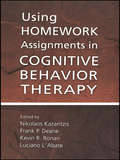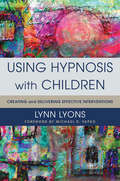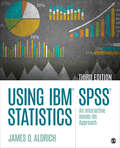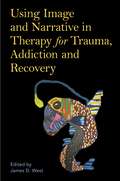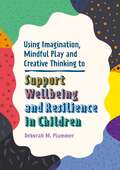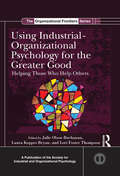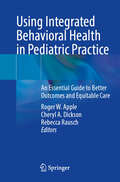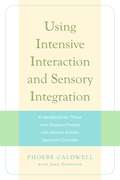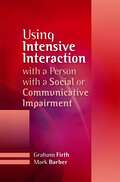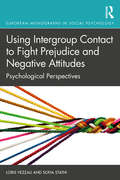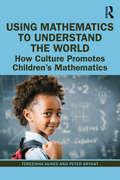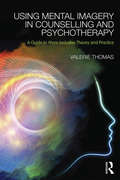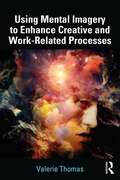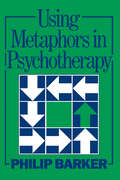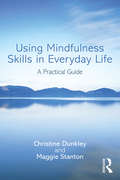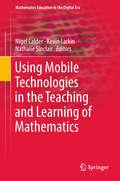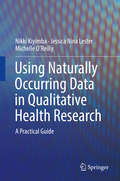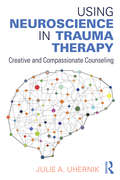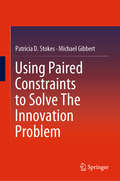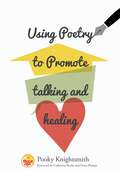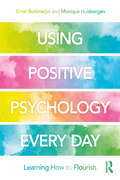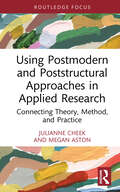- Table View
- List View
Using Homework Assignments in Cognitive Behavior Therapy
by Nikolaos Kazantzis Frank P. Deane Kevin R. Ronan Luciano L’AbateHomework is a central feature of Cognitive-Behavioral Therapy (CBT), given its educational emphasis. This new text is a comprehensive guide for administering assignments. The first part of the text offers essential introductory material, a comprehensive review of the theoretical and empirical support for the use of homework, models for practice, and systems for evaluating client compliance and therapist competence in administering assignments. Part two focuses on the role of homework in cognitive therapy, demonstrating successful methods of integration and discussing solutions to common barriers. Rather than offering one-size-fits-all, pre-designed tasks, this book illustrates application of a model with detailed case study and recommendations for adjusting administration methods for particular problems and specific client populations. Over the last nine chapters, homework administration is described within cognitive and behavioral therapy for anxiety and depression, chronic pain, delusions and hallucinations, obsessions and compulsions, marital and sexual problems, personality disorders, children and adolescents, group and family therapy, and older adults. Readers are provided with a full range of knowledge to successfully incorporate individualized homework assignments into their practice to maximize the proven long-term benefits of CBT.
Using Hypnosis with Children: Creating and Delivering Effective Interventions
by Michael D. Yapko Lynn LyonsHow to create and deliver effective hypnotic interventions with children. From the initial interview to creating the best metaphors, Using Hypnosis with Children is a practical, step-by-step guide that shows health care providers (including therapists, nurses, pediatricians, dentists, and educators) how to create and deliver hypnotic interventions that are customized and effective into their pediatric clinical work, with utilization and flexibility as key components to an overall treatment approach. Using case examples of language for all age groups, readers learn first how to identify the salient targets or themes, deliver a session that hits these targets with precision, and then connect the session to the child's everyday experience. More broadly, readers learn to use hypnosis as a way to help create new neural pathways, teach self-regulation, introduce a more internal locus of control, and develop positive interpersonal experiences. Chapters focus on the most common issues that children face, including anxiety, depression, medical procedures/pain, and sleep.
Using IBM SPSS Statistics: An Interactive Hands-On Approach
by James O. AldrichNow with a new companion website! Using IBM® SPSS® Statistics: An Interactive Hands-On Approach, Third Edition gives readers an accessible and comprehensive guide to walking through SPSS®, providing them with step-by-step knowledge for effectively analyzing their data. From entering data to working with existing databases, and working with the help menu through performing factor analysis, Using IBM® SPSS® Statistics covers every aspect of SPSS® from introductory through intermediate statistics. The book is divided into parts that focus on mastering SPSS® basics, dealing with univariate statistics and graphing, inferential statistics, relational statistics, and more. Written using IBM® SPSS® version 25 and 24, and compatible with the earlier releases, this book is one of the most comprehensive SPSS® guides available. Bundle Using IBM® SPSS® Statistics: An Interactive Hands-On Approach with SAGE IBM® SPSS® Statistics v24.0 Student Version and SAVE! – Bundle ISBN: 978-1-5443-5071-4
Using IBM SPSS Statistics: An Interactive Hands-On Approach
by James O. AldrichNow with a new companion website! Using IBM® SPSS® Statistics: An Interactive Hands-On Approach, Third Edition gives readers an accessible and comprehensive guide to walking through SPSS®, providing them with step-by-step knowledge for effectively analyzing their data. From entering data to working with existing databases, and working with the help menu through performing factor analysis, Using IBM® SPSS® Statistics covers every aspect of SPSS® from introductory through intermediate statistics. The book is divided into parts that focus on mastering SPSS® basics, dealing with univariate statistics and graphing, inferential statistics, relational statistics, and more. Written using IBM® SPSS® version 25 and 24, and compatible with the earlier releases, this book is one of the most comprehensive SPSS® guides available. Bundle Using IBM® SPSS® Statistics: An Interactive Hands-On Approach with SAGE IBM® SPSS® Statistics v24.0 Student Version and SAVE! – Bundle ISBN: 978-1-5443-5071-4
Using Image and Narrative in Therapy for Trauma, Addiction and Recovery
by James D. WestWith contributions from well-respected figures in the field, this book explores the use of narrative and image in the therapeutic treatment of trauma and addiction. The book considers topics such as early trauma and its impacts, therapeutic methods based on images and narrative, and recovery and post-traumatic growth through community engagement. Despite a close practical association between the two, trauma and addiction are often addressed or treated separately. By considering them together, this book offers a rare perspective and is an invaluable tool for art and narrative therapists, as well as professionals supporting those dealing with addiction or trauma.
Using Imagination, Mindful Play and Creative Thinking to Support Wellbeing and Resilience in Children (Helping Children to Build Wellbeing and Resilience)
by Deborah PlummerForms part of JKP's 'Helping Children to Improve Wellbeing and Resilience' seriesUsing a model of 'mindfulness play' to help children to achieve wellbeing, this book encourages children to build awareness of their inner and outer worlds. This multidimensional approach, designed and developed by an experienced speech and language therapist, centres on the importance of play activities to build psychological, emotional and social wellbeing and looks into the pivotal role adults play in supporting a child's self-esteem. By promoting the growth of self-esteem in different areas of a child's life, the book shows how adults help children to establish a firm basis of wellbeing from which they can flourish.The accompanying activity booklets that demonstrate the practical application of this approach are:· Helping Children to Manage Transitions· Helping Children to Manage Stress· Helping Children to Manage Friendships· Helping Children to Manage Anger· Helping Children to Build Self-Confidence · Helping Children to Build their Communication SkillsThe strategies in this ebook guide show how imagination, mindfulness and creativity can enhance our daily interactions with children, and the activity books encourage children to build life skills through structured experiences and through experimenting with different ways of thinking and 'being'.
Using Industrial-Organizational Psychology for the Greater Good: Helping Those Who Help Others (SIOP Organizational Frontiers Series)
by Lori Foster Thompson Julie Olson-Buchanan Laura Koppes BryanThis SIOP Organizational Frontiers volume will be one of the first to show how the field of Industrial Organizational psychology can help address societal concerns, and help focus research on the greater good of society. Contributions from worldwide experts showcase the power the IO community has to foster, promote and encourage pro social efforts. Also included will be commentary from an eminent group of IO psychologists who give invaluable insights into the history and the future of IO psychology . By presenting the prosocial contributions, from personal satisfaction and career commitment to organizational effectiveness to societal development, the imperative and easibility of using I-O psychology for the greater good becomes increasingly compelling.
Using Integrated Behavioral Health in Pediatric Practice: An Essential Guide to Better Outcomes and Equitable Care
by Roger W. Apple Cheryl A. Dickson Rebecca RauschIntegrated behavioral health plays a very important role in the pediatric practice. This book demonstrates that mental health, behavioral health, and psychology are an integral part of whole person medical care while helping to outline a path for the medical community to integrate behavioral health into their practices. A comprehensive description of integrated behavioral health for general pediatrics is described in the first section of this text. It includes recommended terminology definitions, advice on building an integrated health service, interventions, intersectionality, models of change, person centered treatment planning and the use of integrated behavioral health in residency training programs. The second section focuses on how health equity is improved utilizing integrated behavioral health. Subsequent chapter focuses include describing how integrating psychologists in pediatric practices improves health equity, discussing improved healthcare for transgender youth, inequities of ethnic minorities and improved care for patients with disabilities. The third and final section describes how pediatric subspecialties are improved using integrated behavioral health. Subspecialties included are endocrinology, allergy and immunology, gastroenterology, obesity and medical weight loss and sleep medicine. Written by experts in the field, Utilization of Integrated Behavioral Health in Pediatric Practice fills a much needed gap in medical literature by providing a comprehensive guide to integrated behavioral health, not only in pediatrics, but also pediatric subspecialties.
Using Intensive Interaction and Sensory Integration: A Handbook for Those who Support People with Severe Autistic Spectrum Disorder
by Phoebe Caldwell Jane HorwoodPeople with severe autism experience the sensory information they receive from the world completely differently to those not on the spectrum. They feel cut off and overwhelmed, and their behaviour can become very distressed. This handbook shows how we can engage with people who are non-verbal or semi-verbal and sometimes even those who have speech but lose the power to process it when they are in crisis. We can help them to make sense of the world. Intensive Interaction uses a person's own body language to make contact with them and Sensory Integration develops the capacity of an individual to receive, process and apply meaning to information provided by the senses through targeted physical activities. These techniques can be used to develop an environment tailored to the particular sensory needs of the person with severe autism, reducing factors that cause distress. With illustrations, case examples and a wide range of tried-and-tested techniques, this practical guide provides indispensable tools for parents, carers and other professionals supporting people with severe autism and other learning disabilities.
Using Intensive Interaction with a Person with a Social or Communicative Impairment
by Mark Barber Graham FirthIntensive Interaction is a highly effective approach for communicating and developing social interaction and engagement with difficult-to-reach individuals. This easy-to-use guide steers readers through the practical application of the approach, showing how positive results can best be achieved. The authors explain clearly how to prepare for, carry out and reflect on the use of Intensive Interaction with a client or family member. A multitude of key questions are addressed, including finding the right setting, evaluating progress and disengaging effectively at the end of a session. In the final section they consider some of the wider implications of the approach, such as developing confidence as a practitioner and incorporating Intensive Interaction into long-term care or educational planning. This practical and accessible book is a useful resource for speech and language therapists, occupational therapists, special school or further education teachers, social care professionals and anyone else caring for or working with people with social or communicative impairments. It will also be useful to practitioners already using the approach.
Using Intergroup Contact to Fight Prejudice and Negative Attitudes: Psychological Perspectives (European Monographs in Social Psychology)
by Loris Vezzali Sofia StathiIn this groundbreaking volume, Vezzali and Stathi present their research program within the larger contact literature, examining classic theories and current empirical findings, to show how they can be used to reduce prejudice and negative attitudes. The contact hypothesis (Allport, 1954) posits that in an environment of equality, cooperation, and normative support, contact between members of distinct groups can reduce prejudice. Whilst considerable research supports this hypothesis, how theory can be tested in the field remains relatively unexplored. In this innovative book, Vezzali and Stathi discuss why relying solely on advancing theory without considering applied aspects integral to contact may limit the scope of contact theory and restrict our understanding of complex social phenomena. Exploring fascinating topics such as the role of contact in reducing implicit prejudice and fostering collective action, applying indirect contact, and promoting positive interactions among survivors of natural disasters, Vezzali and Stathi explain how contact theory can be implemented and enhance the societal impact of intergroup contact research. Featuring extensive discussion on intergroup contact literature, future directions, and the necessity of applied research, this book will be essential reading for both students and academics of social and behavioral psychology.
Using Mathematics to Understand the World: How Culture Promotes Children's Mathematics
by Peter Bryant Terezinha NunesUsing Mathematics to Understand the World: How Culture Promotes Children's Mathematics offers fundamental insight into how mathematics permeates our lives as a way of representing and thinking about the world. Internationally renowned experts Terezinha Nunes and Peter Bryant examine research into children’s mathematical development to show why it is important to distinguish between quantities, relations and numbers. Using Mathematics to Understand the World presents a theory about the development of children’s quantitative reasoning and reveals why and how teaching about quantitative reasoning can be used to improve children’s mathematical attainment in school. It describes how learning about the analytical meaning of numbers is established as part of mathematics at school but quantitative reasoning is emphasized less even though it is increasingly acclaimed as essential for thinking mathematically and for using mathematics to understand the world. This essential text is for all students of mathematics education, developmental psychology and cognitive psychology. By including activities for parents and professionals to try themselves, it may help you to recognize your own quantitative reasoning.
Using Mental Imagery in Counselling and Psychotherapy: A Guide to More Inclusive Theory and Practice
by Valerie ThomasThe therapeutic potential of working with clients' mental images is widely acknowledged, yet there is still little in the counselling and psychotherapy literature on more inclusive approaches to the clinical applications of mental imagery. Using Mental Imagery in Counselling and Psychotherapy is a unique, accessible guide for counsellors and psychotherapists who wish to develop their expertise in this important therapeutic practice. Contemporary practitioners have at their disposal a large repertoire of imagery methods and procedures comprising the contributions from different therapeutic schools and clinical innovators. Valerie Thomas identifies some of the common features in these approaches and offers a transtheoretical framework that supports integrative practitioners in understanding and using mental imagery to enhance therapeutic processes. The book: Examines the development of the theory and practice of mental imagery within a wider context of the history of imagination as a healing modality; Describes the different ways that mental imagery has been incorporated into therapeutic practice and evaluates recent developments; Reviews explanations of the therapeutic efficacy of mental imagery and considers how recent theoretical concepts provide a means of understanding the role that mental images play in processing experience; Includes reflections on ways to develop more inclusive theory and proposes a model that can inform integrative practice. Using a wide range of clinical vignettes to illustrate theory and cutting-edge research, Valerie Thomas proposes a new integrated model of practice. Providing clear and detailed guidance on applying the model to clinical practice, the book will be essential reading for psychotherapists and counsellors, both in practice and training, who wish to harness the therapeutic efficacy of mental imagery.
Using Mental Imagery to Enhance Creative and Work-related Processes
by Valerie ThomasIn Using Mental Imagery to Enhance Creative and Work-Related Processes, Valerie Thomas explores the productive use of mental imagery skills to engage with the processes of creativity. Practical and original, the book offers detailed guidance for a highly effective method that can provide rich insights into the development of a range of creative enterprises, including artistic and work-related projects. In this accessible and innovative book, Thomas pays equal attention to the theory and application of mental imagery. First, she explains how imagination-based methods have been developed and theorised within the discipline of creative behaviour, especially with regard to dual-processing theories of creativity. The book then considers mental imagery as a dialogical method informed by contemporary post-Cartesian theories of embodied cognition that reprise an earlier premodern understanding of imagination as a mediator between body and mind. Thomas introduces a particular approach to mental imagery that, informed by a functional research-informed framework (the Interactive Communicative model of mental imagery), can be applied very effectively to creative processes. The second half of the book provides detailed guidance on how to apply this particular method and is copiously illustrated with case vignettes. It includes chapters on using imagery theorised as conceptual metaphors such as the plant image for representing creative capabilities and the building image for representing creative and work-related projects. It also explains how to use imagery to represent and work with the conceptual processes of undertaking qualitative research projects. This original and wide-ranging book advances the scope and use of creative image-work in diverse settings. It will be an essential resource for everyone who is interested in developing their own mental imagery skills for creative real-world applications and for all professionals such as coaches, therapists and research educators who want to facilitate creativity in others.
Using Metaphors In Psychotherapy
by Philip BarkerPublished in the year 1982, Using Metaphors in Psychotherapy is a valuable contribution to the field of Psychotherapy.
Using Mindfulness Skills in Everyday Life: A practical guide
by Christine Dunkley Maggie StantonIn the last decade, more mental health treatments have begun to incorporate mindfulness as a skill to help people with their problems. Despite this, not everyone is sure how to incorporate mindfulness effectively into their daily lives. Giving simple explanations, examples and exercises, Using Mindfulness Skills in Everyday Life shows clearly how this is done. The book, written by two NHS clinicians experienced in teaching mindfulness, takes a down-to-earth approach, providing straightforward answers to the most commonly asked questions. The authors give definitions of mindfulness and guide people through instructions on how to set up and evaluate simple practices. As each component is taught, they provide examples of real-life situations, so the reader can clearly see how to be more mindful as they face the ups and downs of modern living. This practical guide is essential reading for anyone who wants to learn mindfulness to help with difficulties and challenges. It is also the perfect book for therapists, coaches, teachers, social workers, nurses, psychiatrists and psychologists to recommend to their clients. The book is ideal for students on clinical training courses.
Using Mobile Technologies in the Teaching and Learning of Mathematics (Mathematics Education in the Digital Era #12)
by Nathalie Sinclair Nigel Calder Kevin LarkinMobile technologies influence the way that we interact with the world, the way that we live. We use them for communication, entertainment, information and research. In education settings, there has been substantial investment in mobile devices, often without a concomitant investment in developing pedagogy and practices. With mobile technologies evolving rapidly, and the number of educational apps growing, there is a need for research into how they facilitate mathematics learning. Such research is of particular importance regarding how such devices may be used to open up new ways of envisaging mathematics and mathematics education, and to help develop conceptual rather than procedural or declarative knowledge. This volume draws upon international research and reports on a range of research projects that have incorporated mobile technologies for mathematics education. It presents research on the use of mobile technologies, such as iPads, iPods, iPhones, Androids, and Tablets, across a diverse range of cultures, year levels and contexts. It examines the ways in which mobile technologies, including apps, might influence students’ engagement, cognition, collaboration and attitudes, through the reshaping of the learning experience. In addition, the book presents appropriate ways to integrate mobile technologies into teaching and learning programmes. It is a significant reference book for those involved with teaching mathematics or using mobile technologies in education, while also offering insights and examples that are applicable to the use of digital technologies in education generally.
Using Music in Child and Adolescent Psychotherapy (Creative Arts and Play Therapy)
by Laura E. Beer Jacqueline C. BirnbaumThere is growing evidence for the powerful role that music plays in enhancing children's cognitive, social, and emotional development. This is the first book to provide accessible ways for any mental health professional to integrate music into clinical work with children and adolescents. Rich case vignettes show how to use singing, drumming, listening to music, and many other strategies to connect with hard-to-reach children, promote self-regulation, and create opportunities for change. The book offers detailed guidelines for addressing different clinical challenges, including attachment difficulties, trauma, and behavioral, emotional, and communication problems. Each chapter concludes with concrete recommendations for practice; an appendix presents a photographic inventory of recommended instruments.
Using Naturally Occurring Data in Qualitative Health Research: A Practical Guide
by Michelle O'Reilly Jessica Nina Lester Nikki KiyimbaThis highly practical resource brings new dimensions to the utility of qualitative data in health research by focusing on naturally occurring data. It examines how naturally occurring data complement interviews and other sources of researcher-generated health data, and takes readers through the steps of identifying, collecting, analyzing, and disseminating these findings in ethical research with real-world relevance. The authors acknowledge the critical importance of evidence-based practice in today’s healthcare landscape and argue for naturally occurring data as a form of practice-based evidence making valued contributions to the field. And chapters evaluate frequently overlooked avenues for naturally occurring data, including media and social media sources, health policy and forensic health contexts, and digital communications. Included in the coverage:· Exploring the benefits and limitations of using naturally occurring data in health research · Considering qualitative approaches that may benefit from using naturally occurring data · Utilizing computer-mediated communications and social media in health · Using naturally occurring data to research vulnerable groups · Reviewing empirical examples of health research using naturally occurring data Using Naturally Occurring Data in Qualitative Health Research makes concepts, methods, and rationales accessible and applicable for readers in the health and mental health fields, among them health administrators, professionals in research methodology, psychology researchers, and practicing and trainee clinicians.
Using Neuroscience in Trauma Therapy: Creative and Compassionate Counseling
by Julie A. UhernikUsing Neuroscience in Trauma Therapy provides a basic overview of structure and function of the brain and nervous system, with special emphasis on changes that occur when the brain is exposed to trauma. The book presents a unique and integrative approach that blends soma and psyche beyond the purview of traditional talk therapy and introduces a variety of trauma-informed approaches for promoting resilience. Each chapter includes case studies, examples, and practical and adaptable tools, making Using Neuroscience in Trauma Therapy a go-to guide for information on applying lessons from neuroscience to therapy.
Using Organizational Theory to Study, Explain, and Understand Criminal Legal Organizations
by Danielle S. Rudes Jason R. IngramThis book explicitly and intentionally uses organizational theory concepts and ideas to examine key issues in the criminal legal realm. Addressing some of the many organizational theories, this volume examines a variety of approaches and theoretical frameworks to explore and explain challenges that are both presented to and faced by the criminal legal system and the individuals served by or working within it. This volume is divided into two parts: organizational theories and organizational concepts and ideas. Within these parts, individual chapters provide readers with new lenses or frameworks for considering criminal legal organization, including one that involves organizational theoretical explanations for how and why criminal legal organizations and their staff and workers operate in these critically salient spaces. The book concludes with a chapter that outlines important considerations for anyone seeking to learn or teach organizational theory as a way of explaining or understanding criminal legal organizations. Additional reading suggestions and two sample syllabi are provided. The book is ideal for criminal justice and criminology undergraduate and graduate students, but is also relevant to individuals considering criminal legal organizations in courses in sociology, law and society, and organizational behavior.
Using Paired Constraints to Solve The Innovation Problem
by Michael Gibbert Patricia D. StokesThis book defines innovation as both a problem and a problem-solving process. It allows readers to approach innovation as a straight-forward problem solving process, and teaches them the paired constraint process to solve specific innovation problems. The authors have used their experience working in creative industries, combined with their academic perspective to create a formal, teachable tool for solving innovation problems. This consists of a formal structure (the problem space), a functional strategy(the paired constraints) and process. (solution by substitution). This book provides a practice section, allowing anyone interested in solving the problem of innovation to learn and develop their skills.
Using Poetry to Promote Talking and Healing
by Pooky Knightsmith Dr Fiona Pienaar Catherine RochePoetry can prove a great way into difficult conversations in therapeutic, classroom or family settings. This book is a clear and practical guide to the use of poetry as a therapeutic tool to help explore issues surrounding mental health and emotional wellbeing. The first part of the book provides guidance on different methods of using poetry to open up discussion. The second part consists of a collection of over 100 poems written by the author, on topics such as bullying, anxiety, bereavement, depression and eating disorders, with a range of therapeutic activities that can be used alongside each poem. The third part focuses on ways to support and encourage clients to write their own poetry and includes 50 poem writing prompts and examples. A complete resource for anyone considering using poetry to explore difficult issues, and a creative way of exploring important mental health issues in PSHE lessons, this book will be of interest to youth, school and adult counsellors, therapists, psychologists, pastoral care teams, PSHE co-ordinators and life coaches, as well as parents.
Using Positive Psychology Every Day: Learning How to Flourish
by Monique Hulsbergen Ernst BohlmeijerWe are all looking to flourish, to experience joy, feel engaged with the world, and experience meaningful lives. But the stresses and strains of our daily lives makes this a challenge. Using Positive Psychology Every Day: Learning How to Flourish is about (re)finding the art of living, enabling you to flourish. Bringing together the best of positive psychology, this book introduces eight evidence-based resources of well-being and flourishing: positive emotions, the discovering and use of strengths, optimism, compassion, post-traumatic growth, positive relationships and spirituality. Each chapter has a concise, simple theoretical introduction and several evidence-based, easy-to-apply exercises. This book is for anyone experiencing stress, distress or lower well-being, as well as coaches and therapists who can use the book for clients in the context of guided self-help.
Using Postmodern and Poststructural Approaches in Applied Research: Connecting Theory, Method, and Practice (Developing Qualitative Inquiry)
by Megan Aston Julianne CheekUsing Postmodern and Poststructural Approaches in Applied Research introduces the complex theoretical approaches of postmodern and poststructural thought in ways that are accessible and understandable. The book begins by grounding our discussion with the foundational work of scholars who first wrote about postmodern and poststructural approaches. We then follow with examples of how scholars continue to use these approaches and theories today and apply them in different practice areas. Examples are provided from the author’s own research, teaching, and mentorship along with activities for the reader, to support them with their own research and application of postmodern and poststructural thought. Interviews and reflections are shared from students and researchers who have used postmodern and poststructural approaches in their own work. This book is for students and researchers who want to use postmodern and poststructural approaches to make a difference in practice areas where they work or have connections. It intends to inspire, excite, and support students, academics, researchers, and practitioners to use postmodern and poststructural concepts in their everyday practices.
